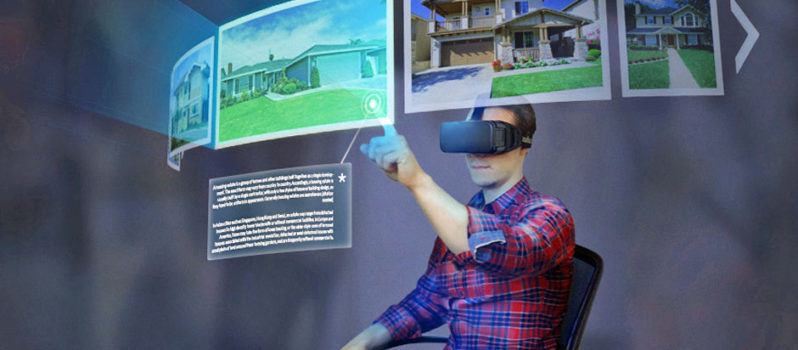Moore’s law predicts that technological advancements will double every two years. That estimate is quickly taking an exponential turn towards doubling every 12 months, and soon, every 12 hours.
Such a remarkable leap still seems too unbelievable to wrap our minds around, but how often have we stopped to look at the advancements around us? Just a decade ago, virtual reality was still an outlandish, fantastical invention. Now, middle school students are spending their classroom time exploring virtual reality with their peers. Without a doubt, we are living in an age where adaptation to technology has become not only a means to get ahead, but a necessity to thrive. Here are six futuristic inventions that have become old news to our high-tech, sophisticated generation:
Virtual Reality
In the 1950s, Morton Heilig famously created the Sensorama, an immersive machine that stimulated the viewers’ visual, tactile, auditory, and olfactory senses. Viewers sat in a vibrating chair and watched 3D short films produced by Heilig himself, while fans from the generator produced smells congruent to what was shown on the tiny screen. That was about the most high-tech VR (virtual reality) contraption for the everyday consumer to enjoy. VR was also fantasized by numerous sci-fi movies, including The Matrix (1999) and Tron (1982), creating a culture that glamorized this immersive technology. Unsurprisingly, when the Oculus Rift and the Samsung Gear VR made its debut in 2015, it didn’t take long before consumers from all over the world began purchasing these futuristic goggles for the chance to experience the virtual world like never before. Now, only two years later, more than 23 million Americans have tried their hands at VR. What was once portrayed as an unrealistic sci-fi gadget is now widely available for students, parents, gamers, and just about anyone who wants to experience high definition virtual reality to enjoy.
Smart Home Technology
From Ray Bradbury’s The Veldt (1950) to Disney’s Smart House (1999), the idea of smart home technology has long been portrayed as the stuff of dystopian nightmares! Society has expressed its distrust in artificial intelligence in numerous films and novels, imagining smart home technology with its own sentient characteristics, such as a human name (‘Alexa’) and even a sense of humor. Thankfully, our intrigue towards smart home technology hasn’t taken a nosedive despite its negative media representations. When the Amazon Echo and Google Home emerged in 2014-2016, we were promised to never have to lift a finger again when it comes to accomplishing tasks on our digital check-lists. Both Google Home and Amazon Echo have thousands of skills, including ordering pizza, arranging Ubers, and tracking our flight statuses. The sales in Amazon Echo reached over 5 million in only two years. Judging from the 53,000 reviews on Amazon, it’s pretty evident that this affordable home technology has been helping people of all socioeconomic statuses and health conditions. It might still be a technological wonder, but one that has successfully made its place in our everyday lives.
Call Tracking
When we say Call Tracking, we’re not just talking about caller ID. Cloud-based Call Tracking allows businesses to track the caller’s name, location, age, ethnicity, and other detailed demographics for a smoother customer service experience. Advanced Call Tracking goes even deeper, tracking the keywords or display advertisements that prompted calls, transferring calls to the right agents based on the caller demographic, and creating comparison reports for marketing optimization purposes. Does that sound impressive? Chances are, you’ve already experienced Call Tracking firsthand. Have you ever made a call from a city with a large minority population and the automatic voice response gave you the option to speak in a different language? You’ve been tracked and serviced according to your geographic location. Now that Call Tracking is a necessity for small and large businesses alike, you’ll recognize Call Tracking employed everywhere—both in online and offline marketing strategies, check out Unlimited Cellular.
Self-Driving Cars
The notion of self-driving cars have been around for so long that even when it’s actualized by Tesla, Uber, and BMW, the overall reaction seems to lean towards, “Finally…” rather than, “Unbelievable!” That’s not to say that this technology is commonplace or even simple by any means. If we take a closer look at the complexities behind autonomous vehicles, it won’t be long before we realize why it took such a long time to develop this technology. Sophisticated machine learning is necessary for interpreting sensors and image data, which is what the vehicle uses to stay on course and dodge unexpected obstacles. Even the autonomous vehicles announced by these large developers will take years before they become readily available for consumers. Still, we have a feeling that when it does make its debut, the world won’t be too shocked.
Drone Delivery
First, there was 2-day shipping. Then came same-day shipping. Now, Amazon is working on delivering your package within 30 minutes of ordering, via Amazon Prime Air! Although Amazon Prime Air won’t be launching for a little while, their first customer trial was conducted last year in the UK. According to the company, they’re still experimenting with different types of drones to get the best results. Drone delivery has already made headlines across all major news stations and media outlets in the US, marking the new and highly anticipated shift towards automated delivery.
In-Store Automatic Checkouts
The future of checkout is nothing less than in-store automatic payments. Take, for example, the Amazon Go store. Prior to Amazon Go, there were already self-service grocery stores popping up all around the nation—stores like Fresh & Easy and Fairway. Even Target, Walmart and Vons have adopted self-service technology to cater to their customers. It’s unsurprising that so many supermarket chains are prioritizing self-service technology, since 75% of consumers regard self-service as a preferred checkout option. Amazon Go takes this a step further by requiring zero checkout time. Customers simply have to access the Amazon Go app and the store’s sensors will automatically take care of the checkout. The magic of automatic checkout is incredible, no doubt, but this store is only the beginning of customer service reform. It’s only natural that in the future, retail chains and other brick-and-mortar businesses will adopt this ultra-convenient technology.





Leave a Reply